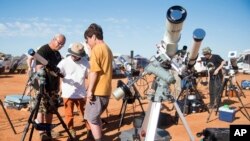Astronomers from around the world gathered in a small town in Western Australia for one of the wonders of the universe - a total eclipse of the sun. First landfall occurred over the northwestern tip of Australia at Exmouth, along the Ningaloo Coast before moving on to parts of East Timor and Indonesia.
Thousands of people gathered at the remote corner of the Western Australian coast to marvel at this rare cosmic symmetry when the sun, the moon and the Earth aligned.
The total solar eclipse was part of a hybrid eclipse, which happens only a handful of times each century. In Western Australia, it stretched across three hours.
The most dramatic part, when the sun was completely blocked out, lasted for barely a minute.
Commonwealth Scientific and Industrial Research Organization radio astronomer Vanessa Moss told VOA total solar eclipses have intrigued and scared people through the ages.
“It reminds us about our place in the solar system,” she said. “These eclipses used to be mysterious things that people could not understand. They used to be bad omens or scary things. But now, thanks to science, thanks to technology that has advanced we can predict them but also just, you know, appreciate more of the wonders of it as opposed to be scared about it. It is actually just a really cool phenomenon to experience.”
For those who were there it was an experience they will likely never forget.
The last hybrid solar eclipse was in 2013. NASA expects the next in 2031.
Scientists used the eclipse to study the Sun’s atmosphere and learn more about distant galaxies.






